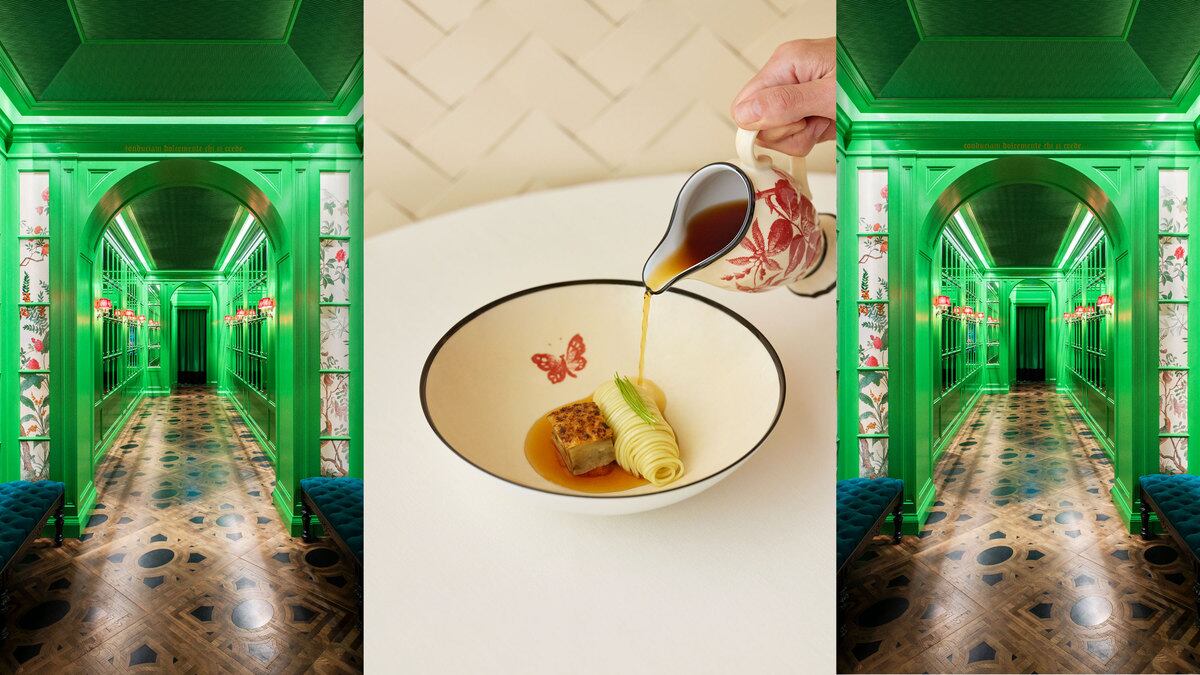Many accomplished chefs toil for decades in the hopes of helming a restaurant that earns a Michelin star, one of the industry’s most coveted accolades. Last week, one year after opening Gucci Osteria Tokyo, which serves Italian cuisine with a Japanese twist above the luxury brand’s second Ginza flagship store, executive chef Antonio Iacoviello learned the restaurant had made the cut.
“It’s like a dream coming true,” Iacoviello told The Daily Beast. “It’s a big step for me.” He was headhunted by Gucci for their Tokyo location while working for chef Massimo Bottura at Osteria Francescana in Moderna, Italy (three Michelin stars).
“When I learned about the project, I fell in love,” Iacoviello told The Daily Beast. “The menu is based on my life story, where I come from and my family. We [the restaurant staff] decide the menu, and Gucci approves my ideas.”
Over the course of his 24-year career, during which he’s worked for iconic chefs like Frenchman Alain Ducasse and Dane René Redzepi, Iacoviello had yet to receive a One Star rating of his own, which in the Michelin guide means “a very good restaurant in its category.”
But in the seven brief years since Gucci opened its first restaurant, 1921Gucci, in Shanghai, high-profile accolades have rapidly come to be expected of the brand’s culinary properties: Gucci Osteria Florence, opened in 2018 and also helmed by Bottura, has one Michelin star.
Chanel has Beige, a Tokyo-based restaurant launched in collaboration with Ducasse with a 30,000 yen ($200) signature menu and a smart-elegant dress code: “jackets or collared shirts, and long trousers are required for gentlemen.” Marni operates a quaint flower café, while Louis Vuitton has just opened another glamorous new restaurant in Saint Tropez after opening its first eatery in Japan in 2020. The Daily Beast reached out to Chanel, Marni and Louis Vuitton for comment.
“Fashion brands used to need to work hard to convince restaurant patrons that they were of quality and worthwhile,” Steven Kamali, CEO of the advisory firm Hospitality House, told The Daily Beast. “Now, it’s widely accepted that they’re operating on the highest tier of the culinary marketplace. In fact, fashion brands have a clear competitive advantage in terms of capital and resources. More importantly, their version of success is not tied to profitability.”
“I don’t get to look at their books, but all these brands must just be writing off their losses,” Pete Wells, restaurant critic for the New York Times, agreed. “You’ll definitely lose money.”

Executive Chef Antonio Iacoviello.
Courtesy Gucci OsteriaRestaurants are notoriously low margin, challenging to staff and entirely dependent upon the whims and behaviors of diners, facts that were never more glaring than during the avalanche of pandemic-prompted business closures during the initial waves of COVID-19.
But for luxury brands, the restaurant gamble often proves to be worth taking. Restaurants “bring customers in who are expected to spend more on leisure and social activities,” Pippa Stephens, a retail analyst at GlobalData, told Vogue last June. “Experiential retail has been massive in stores in order to stop people from shifting completely to buying fashion online.”
Fashion branded culinary offerings range from casual breakfast staples to opulent, emulsified multi-course dinners. In addition to espresso, Ralph’s Coffee, a posh café overseen by Ralph Lauren with four locations in New York, offers branded $50 mugs and $115 cake platters. Lauren also oversees the midtown swish of the Polo Bar, and other venues in Chicago, Milan, Paris, and Chengdu.
At BG on Fifth, a new restaurant opened by luxury department store Bergdorf Goodman last October, customers can recharge with $41 lobster salads tossed with cucumber and blood orange before heading back inside for retail therapy.
“Brands are attempting to democratize their product with ventures like coffee and pastries, but I also think a big part of this is that it’s another arena where brands can create a sense of supremacy, by which I mean supremacy amongst one another,” Kamali said. “It was clothes, then home or personal care and now food. Who does it best?”
“These brands resonate with consumers,” Kamali said. “Someone may not be able to afford the clothes, but they can likely afford a cup of coffee with the brand’s name on it.”
Each fashion brand also comes with its own unique aesthetics and signifiers that can be transmuted into the realm of cuisine, via both restaurant design and the food itself.

Gucci Osteria Tokyo interior.
Courtesy Gucci OsteriaGianni’s, named for Gianni Versace and located in the former Versace mansion, gleams with flashy neon lighting and old-world opulence.
Gucci Osteria Tokyo’s interiors evoke the brand’s eclecticism with the restaurant’s use of Gucci Décor’s flowery Tian wallpaper, peacock velvet banquettes, marble dinner tables and a hand-painted floor pattern inspired by Gucci creative director Alessandro Michel’s antiques collection.
“For a regular restaurant, it’s more about ingredients and quality,” Iacoviello told The Daily Beast. “When you work for a company like Gucci, they want the same ingredients and the same quality, but they want you to pair the [menu] program with the colors and the styles that they use for their clothes.”
With that being said, Gucci “usually leaves my mind free,” Iacoviello said. “The restaurant is connected to the Gucci store that we have downstairs, so basically, I just take a walk downstairs and see what’s going on with Gucci” to get inspiration for his menu, the chef said.
“People who love fine dining, plus people who are curious about the connection between Gucci and Osteria Francescana” make up most of Osteria Tokyo’s clientele, Iacoviello said. “Even if you came only to see the Gucci restaurant, you will fall in love and come back to try our food again.”
One of the chef's favorite dishes on the menu is “a parmigiana that wants to become a ramen,” Iacoviello told The Daily Beast. The dish replaces wheat spaghetti with soba noodles and uses eggplant broth in the absence of carbonara. “It’s a dish that unifies Italy and Japan, and it’s dedicated to the memory of my beloved father.”
In 2024, the Italian jewelry brand Bulgari will open a Miami hotel and restaurant designed by Milanese architecture firm Antonio Citterio Patricia Viel and helmed by Michelin-star chef Niko Romito. Miami, with its opulent annual Art Basel Miami Beach fair and ultra-rich jet setter community, seems like the perfect setting for a fashion house that trades in diamonds. ACPV architects in charge of the project were unavailable for comment.
Luca Fantin, the chef behind Bulgari’s Il Ristorante in Tokyo, told The Daily Beast that conceptualizing the menu is “not about gaining inspiration from the design of jewelry. It’s about more fundamental notions from which I draw ideas. It’s techniques of excellence, elegance, beauty, a quality experience, etc. We offer a gastronomic experience that cannot be expressed on the plate alone.”
Wells reviewed Giorgio Armani’s Armani Ristorante in 2013 and wrote that Sandro Romano’s menu was “at its best when it takes its cues from the understated style of Milan, Mr. Armani’s base of power. The rice in black risotto with speck-wrapped cuttlefish had precisely the firm but creamy texture it should.”
“The thing that was interesting to me about it was that the prices seemed pretty reasonable for fancy midtown Italian food, which is almost its own genre of Italian food,” Wells told The Daily Beast.
“I always wanted the Armani brand to become an expression of style as a lifestyle of sophisticated simplicity, as a sign of elegance in every field,” Giorgio Armani told The Daily Beast. “Food, one of the most important elements of everyday life, could not be missing.”
“Armani Ristorante presents an innovative cuisine that matches with the traditional Italian one and offers the possibility to taste exclusive dishes, with impeccable service, in a unique and sophisticated environment,” Armani said.
“I don’t think any of the places we’re talking about really aspire to be ‘good enough,’ I think that they’re all trying to be good, but honestly, I don’t fully understand the rationale,” Wells added. “The Ralph Lauren Polo Bar is, in a certain way, like the brand come to life, but is that better than taking out a billboard or a TV ad? I really don’t know.” Ralph Lauren was unavailable for comment.
For the moment, it seems as though luxury fashion brands betting on restaurants is a strategy that’s just beginning to gather steam. Harrods, the U.K. department store that got its start nearly 200 years ago selling groceries, will open a Nordic-French restaurant called Studio Frantzen in November and plans to open another in 2024 with chef Dave Pynt.
More mid-sized brands, like Philosophy di Alberta Ferretti and Borsalino, are also getting in on the culinary action, indicating a broader shift: you don’t have to have LVMH-level clout to branch out into restaurants.
“I would expect that we’ll see more of them but they may become more explicitly designed for Instagram,” Wells said. “It just seems like a natural next step, given how important visual environments have always been for the fashion business.”
“The concept is here to stay,” Kamali said. “Brands will transcend food trends, and they will certainly be an exciting part of the culinary industry for many years to come.”
However, the brands that will likely continue to forgo restaurants entirely fall under the category of fast fashion, which depends upon the domination of online shopping that luxury brands are fighting against.
Companies like H&M and Uniqlo are primarily driven by online sales, and don’t need to provide the intimate client services (personal advisors, comped travel) that luxury brands are having to lean on in order to establish deep bonds with their customers.
Plus, with many fast fashion purveyors shutting down thousands of physical retail locations in recent years, opening a costly restaurant could only be counterintuitive for a business like Zara: “There’s no upside,” Kamali said.
And then there are e-commerce juggernauts like Shein, which dominates the fast fashion market with zero brick-and-mortar shopfronts: why would they change their dizzyingly lucrative strategy to launch a bistro?
Luxury houses are facing different challenges. “Fashion shows used to be the primary way for fashion brands to express themselves—the couture show is the aspirational representation of the brand, and then the more affordable options would represent the watered-down version of couture,” Kamali said. “Food is now being utilized in the same way. Michelin stars are the couture options, while coffee and pastries are what can be found on the racks.”
“Ultimately, people want the coffee cup so that they can bring a piece of Ralph Lauren or Gucci home with them,” Kamali said.







